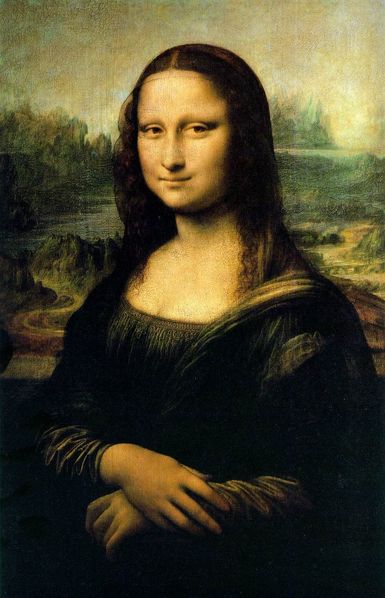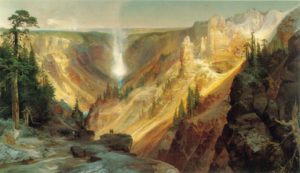 The Mona Lisa is regarded as the most ‘meaningful’ and famous painting in the history of art. Over 500 years old, Mona has aged gracefully and continues to inspire reproduction, parody, scientific theory, movies and more.
The Mona Lisa is regarded as the most ‘meaningful’ and famous painting in the history of art. Over 500 years old, Mona has aged gracefully and continues to inspire reproduction, parody, scientific theory, movies and more.
Today, many of us artists strive to create our own ‘Mona Lisa‘ in hopes of leaving an ‘meaningful’ trace of ourselves behind.
But, how does an artist truly create meaning in his or her work?
That question is baffling to most…
What is ‘MEANING’?
- Meaning is the responsive chord that is struck in the sensibilities of the viewer.
This is how Leonardo created ‘meaning‘ in the Mona Lisa:
- The genius artist, Leonardo Da Vinci possessed as much mystique as his subject.
- The painting style was revolutionary using innovative
techniques sfumato, chiaroscuro and a pyramidal composition. - The identity of the Mona Lisa is a mystery to this day.
- The mysterious Mona Lisa was dubbed a femme fatale adding intrigue and mystery to the meaning of her smile.
- Da Vinci took over four years to finally finish the painting. After completion, he carried the painting everywhere tucked under his arm he went and he did this until his death.
- The painting never left his side when he was still alive and because of this, more and more people became truly interested on the Mona Lisa painting.
- The realism of the painting the translucency of the flesh and the creativity of the background in relation to the figure all contributed to this.
- Regarded as a masterful work, the Mona Lisa was copied by many painters in Da Vinci’s lifetime, including Raphael.
Most of us will not create a masterful work of this level. Nevertheless – I have listed a few thought-provoking and useful ways that will help bring more meaning to your own artwork:
- Paint striking aspects of your own local scenery. Concentrate on dramatic, fragile, or beautiful points of interests in which you live and work.
- 19th century landscape artist, Thomas Moran, painted glorified Luminist landscapes that had not been seen by most Americans.

- Capture a remote sense of nostalgia in your work. Bring back popular or significant aspects of historical, classical or regional subjects, interests or vistas.
- Learn how to understand and use the hidden meaning of color in your art, design and paintings.
- “Pitch your tent in the shadow of a great edifice.”
- Paint works that are thematically or technically linked to some widely recognized work. And, I do not mean copy – Only be inspired by…
For Instance…my still life paintings are loosely inspired by the Dutch masters.
- Without knowing why, collectors say they are drawn to my works because they evoke a sense of comfort and nostalgia.
- But, I know the real reason. Humbly, I ‘pitch my tent in the shadow of a great edifice’!
- My work harkens back to a familiar form of art we all learned about in history class.
- I do this by using the same warm, sepia undertones.
- I also have my light source moving from left to right like most of the old masters. They did this because they knew we obviously read from left to right – this is natural to the eyes.
We are often mislead to think that art is not true art unless it says something new and different. They say we are just technicians – not artists! I believe this is why so many people leave art school feeling overwhelmed with no sense of direction.
Many spend years trying to paint important, new or shocking pieces and never become successful. It can be a curse!
This happened to my talented, Great-Uncle John McNee. He was a close friend and follower of Picasso. Although Uncle John was very talented, he never really found his own artistic expression. He was a frustrated artist.
So I say this: “Let your passion and talent drive your paint brushes!”
Paint what inspires you and it will add meaning to your work. Utilize the historical works of others or nostalgia for the things of the past to help you create artwork that is meaningful to contemporary collectors. When your paintings captivate an audience you will then know how to create meaning in your work.
I’d love to hear what YOU think…~Lori 🙂
*****
You might like to read:
10 Tips to Bring Visitors to Your Art Fair Booth or Open Studio
7 Creative Ways to Approach an Art Gallery for Representation
3 Steps to Find Art Gallery Representation
Visual Artist’s Challenge II – Balancing Self Promotion & Gallery Representation
You Are in Charge of Your Art Career!
Commissioned Art – Tips to make it a Success!
Create a Powerful Portfolio
The Right Art Gallery – How to Find One








Wow Lori – what a great article. I love how you bridged from “meaning” in the Mona Lisa to how to create “meaning” in art today. I think that sometimes we get so caught up in the romance of the great art of the past that we forget that great art is also happening today in studios all over the world.
I think your line, “Paint what inspires you and it will add meaning to your work” speaks volumes. The best art I have ever seen – from any time period – is always the art where the artist was so absorbed in their work that their analytical minds were left out of the frame.
Thanks for writing this.
Daniel.
Hi Daniel, thanks for sharing your thoughts.
I am glad you liked this post. Obviously, I agree that the best art comes when the artist ‘is absorbed’ in his or her work and inspiration takes over the analytical mind. Thanks agian for commenting!
Best- Lori 🙂
Lori,
Great post. We all need to find our passion and inspiration and good things will happen. It is obvious you have found yours with your painting and writing.
Thanks again for the great article.
Chris
Thanks for the nice words, Chris. Passion drives those paint brushes for sure! We all need passion…
Best-
Lori
These articles where phenomenal. I constantly always asked myself the question of the meaning in which I paint. I love nature and abstract illusions. Thanks for answering my thought.
Yay Kelly! I am so glad you found some answers to your question. It is obviously a subject that I ponder myself.
Best-
Lori
I’ve spent the lasat 2 days reading so much information through this website of yours. Thank you for it all, it helps me to feel connected. I love this segment about meaning in your work. I too as an artist strive to produce luminosity on my work, tell a story and relay mystery. I am not a fan of flat painting that seems to be devoid of brushwork and underlayers. I think that is where the artist’s personality and story comes to fruition. You can see and feel the artist at work. I am over the concept that you have to come up with something new. I would rather believe that the artist should come up with something that comes from the heart and therefore is true. It’s all about connection for me and I think this is what will stand the test of time in fine art.
Hello Desley,
I have spent the past few days trying to catch up on valuable comments like yours! Thank you for your patience. I am so grateful to hear you are enjoying this blog. The ‘Mona Lisa” post was a fun one to write and I am happy you gleaned something from it.
My best-
Lori
Excellent article! I need to take time to reread it but it is so timely for me as I try to figure out where I want to go with my work. Thanks for giving me something to think about!
Karen
Hello Karen,
It’s great to hear you enjoyed this article. I wrote it one day after contemplating my own art…it has given me a lot to think about too – lol!
Happy painting,
Lori
Great blog Lori. Very well written and very insightful!
That is a nice compliment coming from you, William! I really enjoyed writing this post. It made me did deep.
Cheers-
Lori
If you paint what is meaningful to you, your paintings will have meaning. That doesn’t just mean the subjects that you choose–a meaningful style or color palette is also important. I also wanted to mention a website I discovered, called “Exhibbit”. It walks you through a virtual gallery of paintings or photographs. Check it out!
Hi Sharon, thanks for adding to the post with your thoughts. I will check out the site you suggested…
The “Mona Lisa”! Oh!
I’ve always been fascinated by colors and symbols in paintings, and I think I’ll explore the historical subjects, too. Thank you for the inspiration, Lori.